专题讲解---介词
- 格式:doc
- 大小:124.00 KB
- 文档页数:7
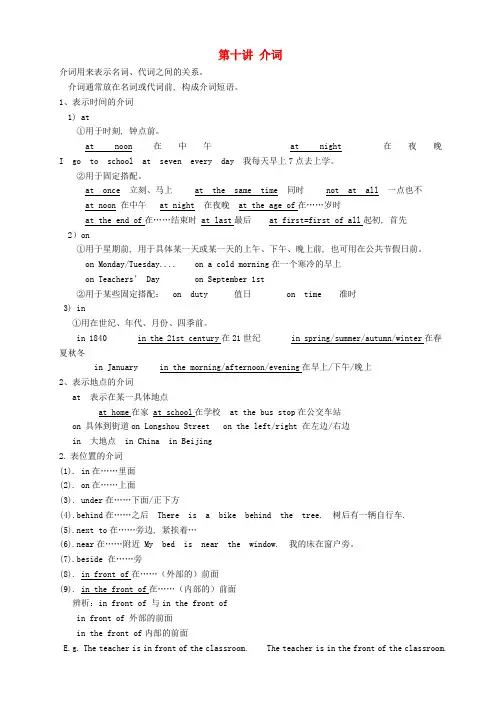
第十讲介词介词用来表示名词、代词之间的关系。
介词通常放在名词或代词前, 构成介词短语。
1、表示时间的介词1) at①用于时刻, 钟点前。
at noon 在中午at night 在夜晚I go to school at seven every day 我每天早上7点去上学。
②用于固定搭配。
at once 立刻、马上 at the same time 同时not at all 一点也不at noon 在中午 at night 在夜晚 at the age of在……岁时at the end of在……结束时 at last最后 at first=first of all起初, 首先2)on①用于星期前, 用于具体某一天或某一天的上午、下午、晚上前, 也可用在公共节假日前。
on Monday/Tuesday.... on a cold morning在一个寒冷的早上on Teachers’ Day on Septembe r 1st②用于某些固定搭配:on duty 值日on time 准时3) in①用在世纪、年代、月份、四季前。
in 1840 in the 21st century在21世纪 in spring/summer/autumn/winter在春夏秋冬in January in the morning/afternoon/evening在早上/下午/晚上2、表示地点的介词at 表示在某一具体地点at home在家 at school在学校 at the bus stop在公交车站on 具体到街道on Longshou Street on the left/right 在左边/右边in 大地点 in China in Beijing2.表位置的介词(1). in在……里面(2). on在……上面(3). under在……下面/正下方(4).behind在……之后 There is a bike behind the tree. 树后有一辆自行车.(5).next to在……旁边, 紧挨着…(6).near在……附近 My bed is near the window. 我的床在窗户旁。
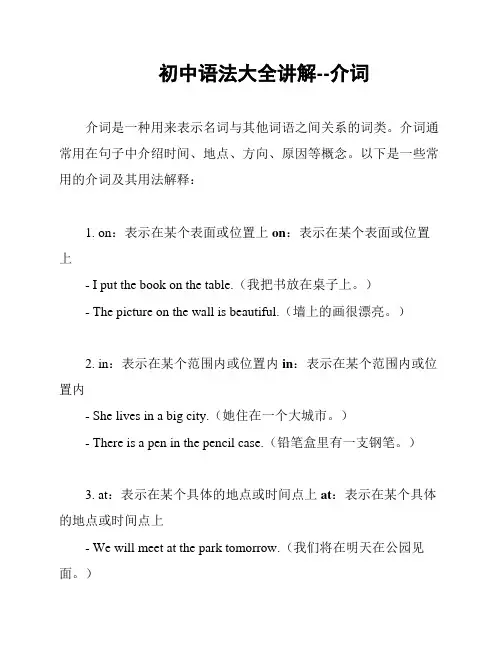
初中语法大全讲解--介词介词是一种用来表示名词与其他词语之间关系的词类。
介词通常用在句子中介绍时间、地点、方向、原因等概念。
以下是一些常用的介词及其用法解释:1. on:表示在某个表面或位置上on:表示在某个表面或位置上- I put the book on the table.(我把书放在桌子上。
)- The picture on the wall is beautiful.(墙上的画很漂亮。
)2. in:表示在某个范围内或位置内in:表示在某个范围内或位置内- She lives in a big city.(她住在一个大城市。
)- There is a pen in the pencil case.(铅笔盒里有一支钢笔。
)3. at:表示在某个具体的地点或时间点上at:表示在某个具体的地点或时间点上- We will meet at the park tomorrow.(我们将在明天在公园见面。
)- He is waiting for you at the front door.(他在门口等你。
)4. to:表示朝向某个目标或对象to:表示朝向某个目标或对象- She walked to school.(她走向学校。
)- Can you pass the book to me?(你能把书递给我吗?)5. with:表示伴随或使用某个工具或对象with:表示伴随或使用某个工具或对象- I went to the park with my friends.(我和我的朋友一起去了公园。
)- He wrote the letter with a pen.(他用钢笔写了这封信。
)6. by:表示通过某种方式或交通工具by:表示通过某种方式或交通工具- We usually go to school by bus.(我们通常坐公交车去学校。
)- She sent the gift by mail.(她通过邮寄发送了礼物。


介词的分类和用法介词是虚词,不能单独作句子成分,必须与名词、代词(或相当于名词的其他词类、短语或从句等)构成介词短语,在句中充当一个成分。
介词分为:简单介词(at, in, for等);合成介词(within, inside, throughout等);短语介词(according to, because of, in spite of等);双重介词(from behind/above/under等);分词介词(considering, including等)。
介词后的宾语可以是名词、代词、动名词、疑问词+不定式、wh–clause等。
1.介词搭配介词的主要考查方式之一就是与动词、名词等搭配成短语,常用搭配形式如下:(1)介词+名词:in turn轮流;in danger在危险中;out of order出故障;by no means决不(2)名词+介词:reason for……的原因;effect/influence on对……的影响(3)形容词+介词:angry with生(某人)气;concerned about关心(4)动词+介词:laugh at嘲笑;agree on对……达成协议(5)动词+副词+介词:go in for爱好,从事;put up with忍受(6)动词+名词+介词:take advantage of利用;pay attention to注意(7)动词+sb/sth+介词:prevent sb from阻止某人做……;remind sb of提醒某人……2.核心介词用法归纳与辨析(1)表示方位的at, in, on, to, beside/by和near介词。
如:this morning, last year。
(5)表示时间段的for和since①besides(除……之外还有), except(意为“除了……”,后可接句子), but, other than,except for(意为“除了……”,后接短语)②with的复合结构:with+名词/代词+现在分词/过去分词/不定式/形容词/介词短语/副词,相当于一个状语从句。
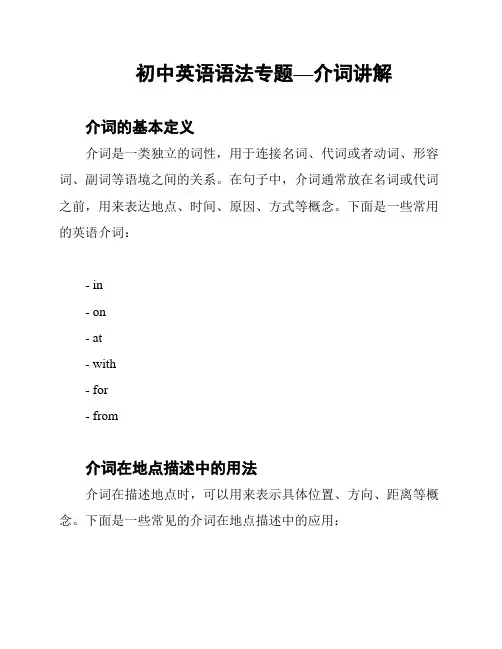
初中英语语法专题—介词讲解介词的基本定义介词是一类独立的词性,用于连接名词、代词或者动词、形容词、副词等语境之间的关系。
在句子中,介词通常放在名词或代词之前,用来表达地点、时间、原因、方式等概念。
下面是一些常用的英语介词:- in- on- at- with- for- from介词在地点描述中的用法介词在描述地点时,可以用来表示具体位置、方向、距离等概念。
下面是一些常见的介词在地点描述中的应用:- in:用于表示在某个范围之内的位置,例如 "in the room"(在房间里),"in the park"(在公园里)。
- on:用于表示在表面、平台或者位置上的状态,例如 "on the table"(在桌子上),"on the bus"(在公交车上)。
- at:用于表示在某个具体位置或者地点,例如 "at the cinema"(在电影院),"at school"(在学校)。
- to:用于表示朝向某个位置的移动,例如 "go to the park"(去公园)。
介词在时间描述中的用法介词在描述时间时,可以用来表示具体时间、时间段等概念。
下面是一些常见的介词在时间描述中的应用:- at:用于表示具体的时间点,例如 "at 7 o'clock"(在7点钟)。
- on:用于表示具体的日期或者星期几,例如 "on Monday"(星期一),"on January 1st"(1月1日)。
- in:用于表示较长的时间段或者某一个时间段内,例如 "inthe morning"(早上),"in July"(在七月)。
介词在原因描述中的用法介词在描述原因时,可以用来表示某事的起因或者原因。
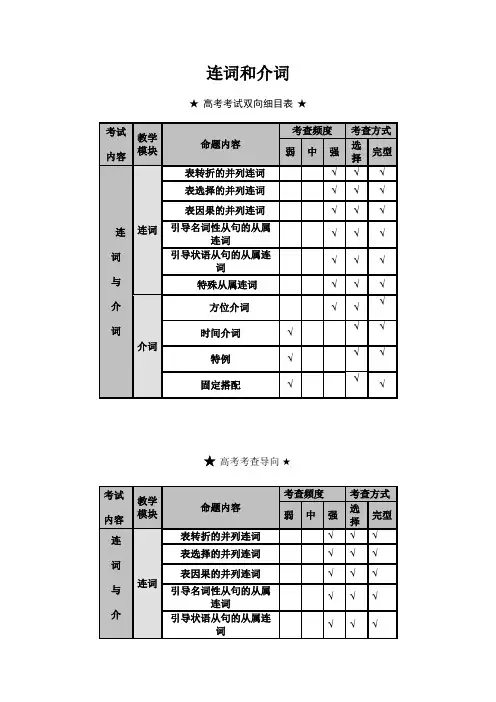
连词和介词★高考考试双向细目表★★高考考查导向★并列连词★教学起点★高考趋式高考试题常设置特定语境考查热点介词和连词与介词的固定搭配及其变形。
连词不能在句子里独立地担当句子成分、而只能起连接作用,连接词与词,短语与短语、句子与句子。
★互动研学★并列连词1.表示转折关系的并列连词有but,yet,still,while,when (然而,偏偏)等。
例1:The car is very old but it runs very fast.这辆小汽车虽然很旧了,但跑得很快。
例2:The winter in Beijing is very cold while that of Kunming is warm.北京的冬天很冷,然而昆明的冬天却很暖和。
例3:Why did you borrow the book when you had one?这本书你有一本,为什么偏偏还借呢?例4:The problem was a little hard, yet I was able to work it out.这道题有点难,然而我却把它做出来了。
例5:I explained twice, still he couldn't understand.我解释了两遍,然而他却还不懂。
注意:while在表示转折关系时,往往连接内容和结构对称的句子。
I love strong tea while my father loves coffee.我喜欢浓茶,然而我爸爸却喜欢咖啡。
2. 表示选择关系的并列连词有or, or else, either…,or…,neither…nor…,otherwise 等。
例1:Would you like to leave or would you like to stay? 你是想走呢还是想留?例2:Do you go to school by bus or on foot? 你上学是坐公共汽车还是走着去?例3:You can come either on Saturday or on Sunday.你可以星期六来也可以星期天来。
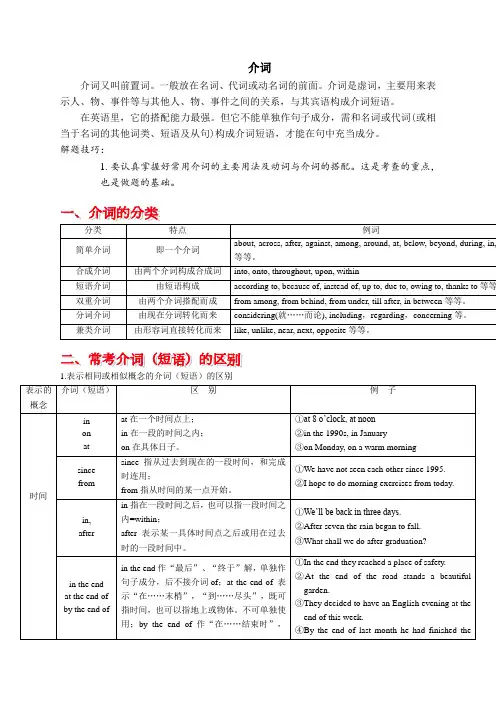
介词介词又叫前置词。
一般放在名词、代词或动名词的前面。
介词是虚词,主要用来表示人、物、事件等与其他人、物、事件之间的关系,与其宾语构成介词短语。
在英语里,它的搭配能力最强。
但它不能单独作句子成分,需和名词或代词(或相当于名词的其他词类、短语及从句)构成介词短语,才能在句中充当成分。
解题技巧:1.要认真掌握好常用介词的主要用法及动词与介词的搭配。
这是考查的重点,也是做题的基础。
1.表示相同或相似概念的介词(短语)的区别“到……末为止”解,只能指时间。
不可单独使用。
novel.位置betweenamong一般说来,between表示两者之间,among用于三者或三者以上的中间。
①You are to sit between your father and me.②He is always happy among his classmates.注意:但有时说的虽然是三个以上的人或东西,强调的是两两相互间接关系时、在谈到一些事物或一组事物,而把它们视为分居两边时以及在谈事物间的差别时,就用between。
①Agreements were made between the differentcountries.②The little valley lies between highmountains.③T hey don’t know the difference between wheat,rice and coin.inontoin表示在某范围内;on指与什么毗邻;to指在某环境范围之外。
①Changchun is in the northeast of China.②Mongolia is on the north of China.③Japan is to the east of China.oninon只表示在某物的表面上,而用in表示占去某物一部分。
①There is a book on the piece of paper.②There is an interesting article in the newspaper.③He dug a hole in the wall.inintoin通常表示位置(静态);into表示动向,不表示目的地或位置。
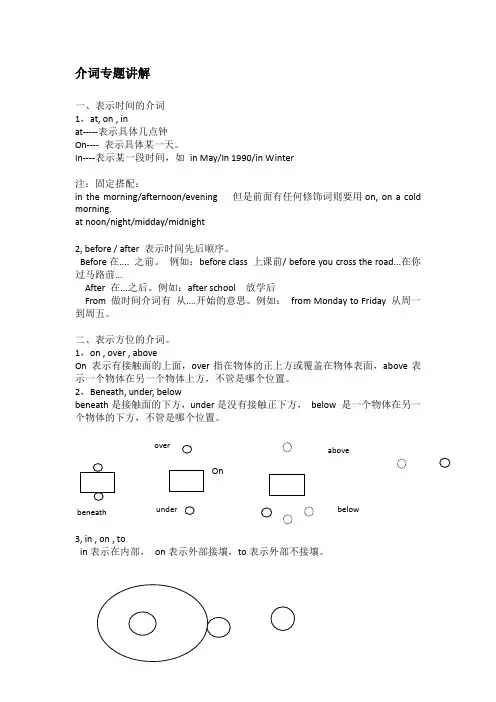
介词专题讲解一、表示时间的介词1,at, on , inat-----表示具体几点钟On---- 表示具体某一天。
In----表示某一段时间,如 in May/In 1990/in Winter注:固定搭配:in the morning/afternoon/evening 但是前面有任何修饰词则要用on, on a cold morning.at noon/night/midday/midnight2, before / after 表示时间先后顺序。
Before 在.... 之前。
例如:before class 上课前/ before you cross the road...在你过马路前...After 在...之后。
例如:after school 放学后From 做时间介词有 从....开始的意思。
例如: from Monday to Friday 从周一到周五。
二、表示方位的介词。
1,on , over , aboveOn 表示有接触面的上面,over 指在物体的正上方或覆盖在物体表面,above 表示一个物体在另一个物体上方,不管是哪个位置。
2,Beneath, under, belowbeneath 是接触面的下方,under 是没有接触正下方, below 是一个物体在另一个物体的下方,不管是哪个位置。
On3, in , on , toin 表示在内部,on 表示外部接壤,to 表示外部不接壤。
3,At 表示在旁边,例如:at the table 在桌子旁边。
4,Behind表示在....后面,例如:behind the door在门后。
5,Beside表示在....旁边。
例如:beside the table在桌子旁边。
6,Between, amongbetween表示在俩者之间,例如:between the two buildings. 在两个建筑物中间。
among表示三个或三个以上之中,例如:among all the ball games在所有球类运动中7,In front of , in the front ofIn front of是在外部的前面。
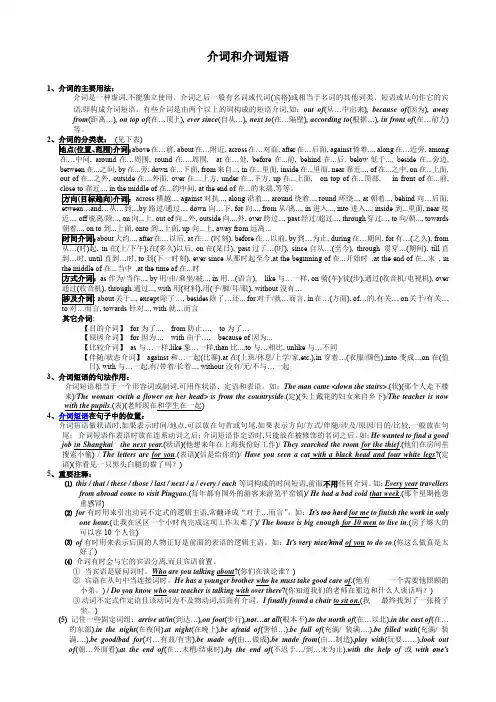
介词和介词短语1、介词的主要用法:介词是一种虚词,不能独立使用。
介词之后一般有名词或代词(宾格..)或相当于名词的其他词类、短语或从句作它的宾语,即构成介词短语。
有些介词是由两个以上的词构成的短语介词,如:out of(从…中出来), because of(因为), away from(距离…), on top of(在…顶上), ever since(自从…), next to(在…隔壁), according to(根据…), in front of(在…前方)等。
2)above在…前, about在…附近, across在…对面, after在…后面, against倚着..., along在…近旁, among周围, round在….周围, at在…处, before在...前, behind在...后, below低于..., beside在...旁边, between在...之间, by在...旁, down在...下面, from来自..., in在...里面, inside在...里面, near靠近..., of在...之中, on在...上面, out of在...之外, outside在....外面, over在....上方, under在...下方, up在...上面, on top of在...顶部, in front of在...前,在...的中间, at the end of在...的末端,等等。
across横越..., against对抗..., along沿着..., around绕着..., round环绕..., at朝着..., behind向…后面,...,by路过/通过..., down向…下, for向..., from从/离..., in进入..., into进入..., inside到...里面, near接近..., off脱离/除..., on向...上, out of向...外, outside向....外, over跨过..., past经过/超过..., through穿过..., to向/朝..., towards 到...上面, onto到...上面, up向...上, away from远离...about大约..., after在…以后, at在… (时刻), before在…以前, by到…为止, during在…期间, for有…(之久), from, in在(上/下午);在(多久)以后, on在(某日), past过了…(时), since自从…(至今), through 贯穿…(期间), till直到…时, until直到…时, to到(下一时刻), ever since从那时起至今,at the beginning of在...开始时,at the end of在...末, in 在...当中,at the time of在...时as作为/当作..., by用/由/乘坐/被..., in用…(语言), like与…一样, on骑(车)/徒(步),通过(收音机/电视机), over), through通过..., with用(材料),用(手/脚/耳/眼), without没有…about关于..., except除了…, besides除了…还... for对于/就…而言, in在…(方面), of…的,有关..., on关于/有关...,, towards针对..., with就…而言其它介词:【目的介词】for为了..., from防止…,to为了…【原因介词】for因为..., with由于…, because of因为...【比较介词】as与…一样,like象…一样,than比...,to与…相比, unlike与…不同【伴随/状态介词】against和…一起(比赛),at在(上班/休息/上学/家,etc.),in穿着…(衣服/颜色),into变成...,on在(值日), with与…一起,有/带着/长着..., without没有/无/不与…一起3、介词短语的句法作用:介词短语相当于一个形容词或副词,可用作状语、定语和表语。

介词I. 介词是一种用来表示词与词, 词与句之间的关系的词。
在句中不能单独作句子成分。
介词后面一般有名词代词或相当于名词的其他词类,短语或从句作它的宾语。
介词和它的宾语构成介词词组,在句中作状语,表语,补语或介词宾语。
II. 介词归类大全一、表示地理位置的介词:(1)at ,in, on, toat (1)表示在小地方; (2)表示“在……附近,旁边”in (1)表示在大地方; (2)表示“在…范围之内”。
on 表示毗邻,接壤to 表示在……范围外,不强调是否接壤例句:He arrived the station at ten.He is sitting the desk.He arrived Shanghai yesterday.Jiangsu lies the east of China.Russia lies the north of China.Fujian is the south of Jiangsu Province.注意:表示“树上有……”时,in和on有区别。
用on表示这个事物属于树的一部分,但是用in表示这个事物在树上,并不属于树的一部分。
练习:There is an apple the tree and a bird the tree.(2)above, over, on 在……上above 指在……上方,不强调是否垂直,与 below相对;over指垂直的上方,与under相对,但over与物体有一定的空间,不直接接触。
on表示某物体上面并与之接触。
例句:The bird is flying my head.There is a bridge the river.He put his watch the desk.(3)below, under 在……下面under表示在…正下方below表示在……下,不一定在正下方例句 There is a cat the table.Please write your name the line.二、表示时间的介词:(1)in , on,at 在……时in表示较长时间,如世纪、朝代、时代、年、季节、月及一般(非特指)的早、中、晚等。
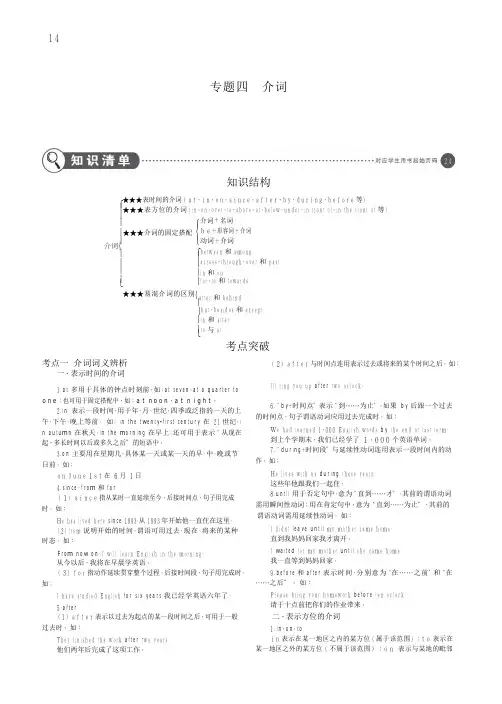
⎪⎧ ⎪ {⎪14专题四 介词知识结构★★★表时间的介词( at、in、on、since、after、by、during、before 等)⎪★★★表方位的介词( in、on、over、to、above、at、below、under、in front of、in the front of 等) ⎪⎪★★★介词的固定搭配 介词⎨⎪ ⎪ ⎪ ⎪ ⎩ 介词+名词 be+形容词+介词动词+介词 ⎧⎪between 和 among ⎪across,through,over 和 past ⎪in 和 on ⎪for,to 和 towards ★★★易混介词的区别⎨after 和 behind⎪but,besides 和 except ⎪in 和 after ⎪⎩to 与 at考点一 介词词义辨析一、表示时间的介词考点突破( 2) after 与时间点连用表示过去或将来的某个时间之后。
如: 1.at 多用于具体的钟点时刻前,如:at seven,at a quarter to one;也可用于固定搭配中,如:at noon,at night。
2.in 表示一段时间,用于年、月、世纪、四季或泛指的一天的上午、下午、晚上等前。
如: in the twenty⁃first century 在 21 世纪,in autumn 在秋天,in the morning 在早上;还可用于表示“ 从现在起,多长时间以后或多久之后” 的短语中。
3.on 主要用在星期几、具体某一天或某一天的早、中、晚或节日前。
如:on June 1st 在 6 月 1 日4.since,from 和 for( 1) since 指从某时一直延续至今,后接时间点,句子用完成 时。
如:He has lived here since 1993.从 1993 年开始他一直住在这里。
(2) from 说明开始的时间,谓语可用过去、现在、将来的某种 时态。
初中英语语法基础介词专题讲解一.介词at/ in /on .1.表示时间:1).表示某一具体时间点,某一时刻/ 年龄at six o’clock at noon at that timeat the moment at the age of at night2)in表示时间段,一天的三个时间段以及月份,年,季节,世纪,人生的某个时期(某人几十岁时)in the morning/afternoon /eveningin spring /in 2007/in Marchin the twenty-first centuryin his fifties3)on表示星期几/某一具体的日子/具体某天的上午/下午/晚上,表示一天中的三个时间段名词前有修饰语或后有修饰语时.On Monday on New Year’s Dayon Sunday morning on a rainy nighton the evening of April 1st ,20072表地点:1)at 一般指较小的地点或较具体的位置at the station at the cinema2)in 表示在较大的地点或一个有限空间里.in China in the classroom3)on 指在某物体的表面上.on the desk注意:写街道时,若有门牌号用at ,否则用on / in 都可.He lives at 270 DongChang’an Street.二.介词in /on / to 表方位:1.in表示A地在B地范围之内.(包含关系)Tanwan is ____ the southeast of China .2.on表示A,B地接壤.(外切关系)Hubei is ____ the north of Hunan .3.to表示A,B两地有一定的间距.(外离关系)Japan is _____ the east of China .三. between / among 在……之间1.between :指两者之间. 在…….之间.2.among :用于三者或三者以上人或物之间. 在……之中.You sit _____ him and me .The song is popular ______ the students.四.after / in 在……之后 before / in 在……之前1. after1)after + 时间段. 表示以过去某一时刻为起点的一段时间之后, 用于过去时.2)after 作介词. after doing sth.2.in +一段时间. 表示说话时或以现在为起点的将来一段时间之后.用于将来时.He came back ______ two days .He will go home___finishing his homework .He will come back _____ two days .3. before 多用于时间点或一件事之前发生,即“先于……;在……之前”He left the office bofore I got there. I’ll be back before five o’clock.4. ago 时间段+ ago 表示“多久之前”时态通常用:一般过去时I met Tom two days ago.五.with / in / by 表示“用……”1.with 表示“用…” 一般指有形的工具/ 手段/ 人体器官.He cut the apple into halves ____ a knife .注: with 表伴随, “带有,含有”He came in _____ a big smile on his face .2.in表示用某种语言,方式,途径. 或书写/绘画所用的材料. 也可表交通方式.Can you say it _____English ?He wrote a letter ____ blue ink .3.by表示乘坐交通工具, 表示方式,方法I study for a test _____ working with a group .He makes a living ____ selling newspapers .注意: 同义词组1).by phone = on the phone2).by car = in a car3).in pen = with a pen = with pens六.across / through / over / by 经过1.across 指横穿,穿过. 表示动作从某一物体表面上经过.2.through 指穿过,透过,表示从某一物体空间内通过.3.over 表示从某人或某物的上空经过或越过,不与表面接触.4.by 表示从某人/某物的旁边经过.Can you swim ______ the river ?the elephant is so big that it can’t go _____ the gate .I don’t think anyone can jump ___ the fenc e.I walked _____ the bank of China yesterday .七.in front of / in the front of1.in the front of 表示在…….内部的前面2.in front of 表示在……外面的前面There is a desk in _____ front of our classroom .There is a big tree in _____ front of our classroom.八.其它介词的用法:1.at的其它用法.1).表示“从事或正在做某事”,其后加的名词往往不加冠词.She is at work now = She is working now .2)at表示“价格或速度”The train ran at 120 kilometers an hour .2.in的其它用法:1)in表示“在……方面”词组:do well in = be good atbe weak in2)in 表示“穿着”后接表颜色的词或衣服.词组: be in +衣服= be wearing +衣服3)in作副词, “在家” = at home3.like 的用法:1).像/和……一样. 常与系动词连用.词组: look like sound like2).与what 连用, “是什么样子, 怎样”.What is he like ? He is kind .4.off的用法:1).从……下来, 脱离某物体.词组: fall off2). “休假”通常放在时间名词之后.词组: have +时间+ offHe has n’t had a night off for two hours .5.except / besides1).except 除了…….之外, 都……. . 不包括在范围之内.注: nothing but … 除了……之外,什么也没有.2).besides除了……之外,还有…… . 包括在范围之内.We all went swimming ______ Lucy .There is _______ a letter in the box .We study Japanese and French____ English .6.with / without1).with具有,含有反义词: without 没有词组: with the help of = with one’s help =because of = thanks towithout one’s help2).without 的用法:A).without + sb./ sth. 没有某人或某物B).without + doing sth . He lef t here without____(say ) “Goodbye”to usC). without sth 常与if 引导的否定的条件句.If there is no water , we can’t live .= We can’t live ______ _______ .7.on the tree /in the treeon the tree 表示“树上本身长的东西” 在树上.in the tree 表示“外界的物体进入树中” 人或物在树上.There are some apples _____ the tree .There is a boy ____ the tree.8.表示“数量的介词”about , round around , over1). about , round around表示“大约……”2).over 表示“超过”= more than.9.inside / outsideInside 在……里面------反义词:outside在….外面10.in the wall /on the wallin the wall 表示“门窗在墙上” on the wall 表示“某东西张贴或挂在墙上”九.不用介词的情况:1).当时间状语为: tonight, today, yesterday, tomorrow 等时,不用介词. What are you going to do tonight ?2).含有this, that, these, those, last, next, every/each day等时间状语.He went to Wuhan last week . I drink milk every day.3).以all 开头的时间状语前面不用介词.He has worked all day .4).以some ,any, one 等构成的时间状语前不用介词.He met a bad man one cold morning. = He met a bad man on a cold morning.介词专题小测:一、单项选择题。
完整版)初中介词和介词短语专题讲解(含练习)介词及介词短语介词是一种虚词,用来表示名词或相当于名词的其它词语在句中的关系,不能单独使用。
介词可与名词或相当于名词的其它词构成介词短语。
介词短语可在句中作定语、状语、表语和宾语补足语。
例如:那个男孩子是XXX的兄弟。
(定语)女孩子两小时后回来。
(状语)介词分为简单介词和复合介词。
常用的简单介词有at、in、on、about、across、before、beside、for、to、without等。
复合介词如by means of、along with、because of、in front of、instead of等。
表时间的介词有以下几种用法:1)at。
in。
on表示时间点用at。
例如:六点钟、中午、午夜。
表示在某个世纪、某年、某月、某个季节以及早晨、上午、下午、晚上时,用in。
例如:19世纪、2002年、五月、冬天、早上、下午等。
表示具体的某一天和某一天的上午、下午、晚上时,用on。
例如:星期一、7月1日、星期日早上等。
2)since。
after由since和XXX引导的词组都可表示从过去某一点开始的时段,但since词组表示的时段一直延续到说话的时刻,因而往往要与现在完成时连用。
而after词组所表示的时段纯系过去,因而要与一般过去时连用。
例如:我自去年夏天以来就没有收到他的消息。
(现在完成时)五天后,那个男孩回来了。
(一般过去时)3)in。
afterin与将来时态连用时,表示“过多长时间以后”的意思,后面跟表示一段时间的词语。
after与将来时态连用时,后面只能跟表示时间点的词语。
文章中介绍了表示时间和地点的常用介词的用法辨析。
当表示一段时间时,应该使用after与过去时态连用,后面跟表示一段时间的词语。
例如:He returned after a month。
当表示地点时,at一般指小地方,in一般指大地方或某个范围之内,on往往表示“在某个物体的表面”。
高考英语复习语法知识专题讲解专题五介词与介词短语一、介词的句法功能1.作定语The key to the door is missing.2.作状语Her eyes were tired from long reading.3.作表语Japan is to the cast of China.4.作宾语补足语Make yourself at home.二.介词的宾语易错点名词、代词Don't forget to turn off the lights before leaving your classroom.Don't hide behind others.数词There was only one piece of cake, but we can cut it into two.The students began to show up by twos and threes.When we went in,we found his room at sixes and sevens.形容词、副词Her pronunciation is far from perfect. His uncle is from abroad. 动词-ing形式I succeeded in passing the driving test.On arriving in Venice, we knew that it was a city of water.动词不定式The plane is about to take off.宾语从句She got very angry because of what he had said.I am thinking of how I shall do more for the people.疑问词+ 不定式短语Marx gave us some advice on how to learn foreign languages. They are discussing how to sell the goods elsewhere.动词原形His father had nothing to do all day except play cards.介词短语The boy jumped from behind the door. The ball rolled out from under the table.三.介词的省略用法易错点1.of的省略The two girls are(of) the same age.2.from的省略Nobody can prevent us(from)getting married. You must stop her(from)telling such lies.3.in 的省略He spends nearly half of his monthly income(in)buying books.He wasted time(in)doing nothing.4.on的省略Keep(on)talking amongst yourselves.I'll be back in a minute.四.常用介词的用法比较集锦1.表示时间in/after in十时间段:一般用于将来时after+时间段:一般用于过去时He'll be back in a week. 他一周后回来。
九年级英语专题复习教案:介词和介词短语知识讲解(中考资料)第一章:介词概览1.1 教学目标让学生理解介词的基本概念和用法。
能够辨别和运用常见介词。
1.2 教学内容介词的定义和分类。
常见介词的用法和例句。
1.3 教学步骤介绍介词的概念和分类。
通过例句展示常见介词的用法。
学生练习辨别和运用介词。
第二章:介词短语2.1 教学目标让学生理解介词短语的概念和用法。
能够辨别和运用常见介词短语。
2.2 教学内容介词短语的定义和分类。
常见介词短语的用法和例句。
2.3 教学步骤介绍介词短语的概念和分类。
通过例句展示常见介词短语的用法。
学生练习辨别和运用介词短语。
第三章:介词和介词短语的辨析3.1 教学目标让学生能够辨别和正确运用介词和介词短语。
3.2 教学内容介词和介词短语的辨析方法。
常见介词和介词短语的混淆点。
3.3 教学步骤介绍介词和介词短语的辨析方法。
通过例题展示常见介词和介词短语的混淆点。
学生进行辨析练习。
第四章:介词和介词短语的运用4.1 教学目标让学生能够熟练运用介词和介词短语。
4.2 教学内容介词和介词短语的运用技巧。
常见介词和介词短语的运用场景。
4.3 教学步骤介绍介词和介词短语的运用技巧。
通过例题展示常见介词和介词短语的运用场景。
学生进行运用练习。
第五章:中考介词和介词短语题型解析5.1 教学目标让学生了解中考介词和介词短语的题型。
掌握解题技巧和方法。
5.2 教学内容中考介词和介词短语的题型分析。
解题技巧和方法。
5.3 教学步骤分析中考介词和介词短语的题型。
分享解题技巧和方法。
学生进行真题练习。
第六章:介词和介词短语的综合练习6.1 教学目标让学生通过综合练习巩固介词和介词短语的知识。
提高学生的综合运用能力。
6.2 教学内容综合练习题:包括选择题、填空题、改错题等。
6.3 教学步骤给学生发放综合练习题。
学生独立完成练习题。
老师讲解答案并指出学生常见错误。
第七章:介词和介词短语的拓展知识7.1 教学目标让学生了解介词和介词短语的拓展知识。
介词专题讲解【掌握要点】1、常用介词得主要用法(表示时间、地点、空间位置得介词得用法)2、介词得固定搭配3、常用几组介词得辨析一、定义:介词就是一种用来表示词与词,句与句之间关系得词。
就是一种虚词。
在句中不能单独作句子成分。
介词后面一般有名词、代词或相当于名词得其她词类,短语或从句作它得宾语。
介词与它得宾语构成介词词组,在句中作状语,表语,补语或介词宾语。
二、介词分类按结构介词可分为3类:1、简单介词(约有70个),如:in,at,on,by,with,down,for,beside,along,across等。
2、分词介词(约15个)如:during,following,considering,according。
3、复合介词(约有500个)如:out of,look after, in front of,becaus eof,按意义英语介词可分为4类:1、时间介词,如:at,on, in,during,over, from, for,until 等。
2、地点介词, 如:at, on, in,across, to, over, between, inside, outside 等。
3 运动介词:如:along,across through4、其它介词,如:by, with, about, except,insteadof,等※(一)、表示时间得介词:1)in , on,at 在……时in表示较长时间,如世纪、朝代、时代、年、季节、月及一般(非特指)得早、中、晚等。
如in the 20thcentury, in the 1950s,in 1989,in summer,in Janu ary, inthemorning, in the night,inone’slife , in one’s thirtie s等。
on表示具体某一天及其某一天得早、中、晚。
如onMay 1st, on Monday, on New Year’s Day,on a cold night in January, onafinemorning,on Sunday afternoon等。
at表示某一时刻或较短暂得时间,或泛指圣诞节,复活节等。
如at3:20, at this time of year,at the beginning of, at the endof…,at the age of…, at Christmas, atnight,at noon, atthis moment等。
注意:在last,next,this, that, some, every 等词之前一律不用介词、如;We meet every day、口诀:“at时间点,有on必有天,in指月季年,也与色相连”就就是说,有具体得时间点得时候用at,具体那一天用on,说到月份,季节,年份,就用in ;而且说谁穿了什么颜色得衣服得时候,也就是用in XX(color)at用于某一具体时刻或重大节日之前①在五点钟______②在中午____③在夜晚___④在圣诞节_____⑤在午夜_____(2)on用在具体某一天或某天得上午、下午、晚上之前①在教师节_________②在周二晚上_________③在星期天_________(3)in用在周、日、季节或泛指得上午、下午、晚上前①在一周内_________②在五月_________③在夏季_________④在2009年_________⑤在下午_________2)、before、afterbefore表示“在某时刻或某件事之前”,after用在时刻或某件事之后。
①We must leave______、八点钟之前我们必须离开。
②________breakfast ,he hurriedtoschool、早餐后,她匆忙上学去了。
3)by、until、till(1)by表示“在……之前,到……为止”You must hand in yourhomework ______nineo’clock、您必须在9点前交上家庭作业。
(2)till与until都有“直到……”或“直到……为止”之意,till多用于口语,且不能放在句首,till与until用于肯定句时,主句中动词得动作一致延续到till或until后得时间为止;till与until用于否定句时,主句中得动词就是瞬间动作,它得动作要到till或until后得时间才发生。
①He cannotbeback_____January、直到一月份她才回来。
②We waited _____10 o’clock last night、昨晚我们一直等到10点钟。
4)in ,after两者都有“在一段时间之后”之意,均可与一段时间连用,in+时间段,表示从现在算起得一段时间以后,与将来时连用。
after+时间段,表示从过去某个时间点算起一段时间后,与过去时连用,此外,after可与一点时间连用,即after+时间点,此时可用于将来时,in 不能与一点时间连用,(1)Iwill finish the work_____two hours、(2)he cameback three days、(3)Hewill arrive 5o’clock、(二)、表示地点得介词:表示方位得介词:in、on、toIn表示“在…内”,on表示“与…相邻”,to表示“在…之外,又不相邻”①Ais inthe northeast of B、②A is onthewest of B、③B is tothe east ofA、Taiwan isabeautiful islandandit’s_____east of Fujian、2、表示“在…之上或之下”得介词above,over,on 在……上above 指在……上方,指笼统得上方,不强调就是否垂直,与below相对;over指垂直得上方,有覆盖得意思,与under相对,over与物体有一定得空间,不直接接触。
on表示某物体上面并与之接触。
Thebird is flyingabovemy head、There is a bridge over theriver、He puthis watchon the desk、3)below,under 在……下面under表示在…正下方below表示在……下,不一定在正下方There is a cat under the table、Pleasewrite your name below the line、My pencil-case is _____ LiLei’s desk、The lampis_____ thetable、Theplane is flying _____ the clouds、飞机在云层上飞行。
3、表示在某地得介词:at、in、onat—表示较小得地点,in—表示较大得地方,on—表示在一个平面上。
①_____ Shanghai、②_____home、③_____ ground、Tom told me hisparents had arrived _____Beijing、4、表示“前、后”得介词⑴in frontof,in thefront of,before 表示“在…之前”in front of = before表示“在某一范围之外得前面”in the front of表示“在某一范围之内得前部”①Tom isshort and always sits _____the classroom、②There is atree_____myhouse、⑵atthe back of,behind, after三者均有“在…之后”之意,atthebackof 就是in the front of得反义词,表示“在某一范围之内得后部”,behind就是in frontof得反义词,表示“在某一范围之外得后面,主要用于位置”,after主要用于时间或次序。
①The couplesare walking _____theirson、这对夫妇跟在她们得儿子后面散步。
②Yourcat is_____the tree、您得猫躲在树后面。
③There’s a blackboard _____theclassroom、教室后面有块黑板。
④There is a bank _____(在…后面)thebus station、5、表示“里外”得介词⑴in表示“在…内”,有静止之意,inside表示“在…里面”、“到…里面”,强调“以…为界”之意, into表示动作得方向,意为“到…内”。
①My walletis _____thedraw、我得钱包在抽屉里。
②The boy rushed_____thehouse、这个男孩冲进房子。
③He was reading English _____the door、她在家里读英语。
⑵outside就是inside得反义词,表示“在…外面”,out of 就是into得反义词,表示“到…外”。
①Don’t look _____the window when you are inclass、上课时不要想窗外瞧。
②They are havinganimportant meeting,please wait_____ the offi ce、她们正在召开一个重要得会议,请在办公室外边等候。
6、from,to,for,1)from 从…、、The trainstarted from Paris、Shewill fly from Beijingto the USA2)to 到…、(目得地)去,向…、、Hewent to Guangzhou lastyear、They gotto the town very l ate、3)for向…、、,表目得方向He left for Tianjin on businessyesterday、Thetrain for Shanghaihas been away、(三)、表示运动方向得介词(1)into, inside, 从外到内:He went quickly into/ inside the room、(2)out of 从里到外,相当于outside, 或从里向外,相当于fromShe wentout of fromtheoffice in a hurry她匆匆走出办公室、Theboy watched thebuses, carsand bikesoutfromthewindow、这男孩透过窗观瞧外面得公交车、小汽车与自行车。
(3) onto 到……上Hejumped onto a tree、她跳上一棵树(4)across 穿过一平面、through 穿过一空间The boy kicked the ball hard and itmoved acrossthe grass、这男孩用力踢球,球飞过草地。